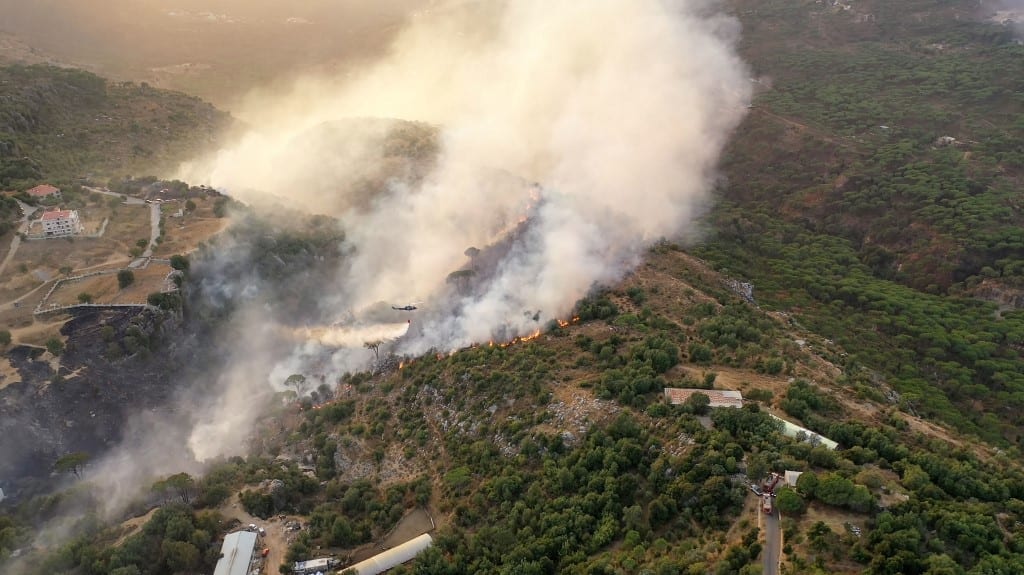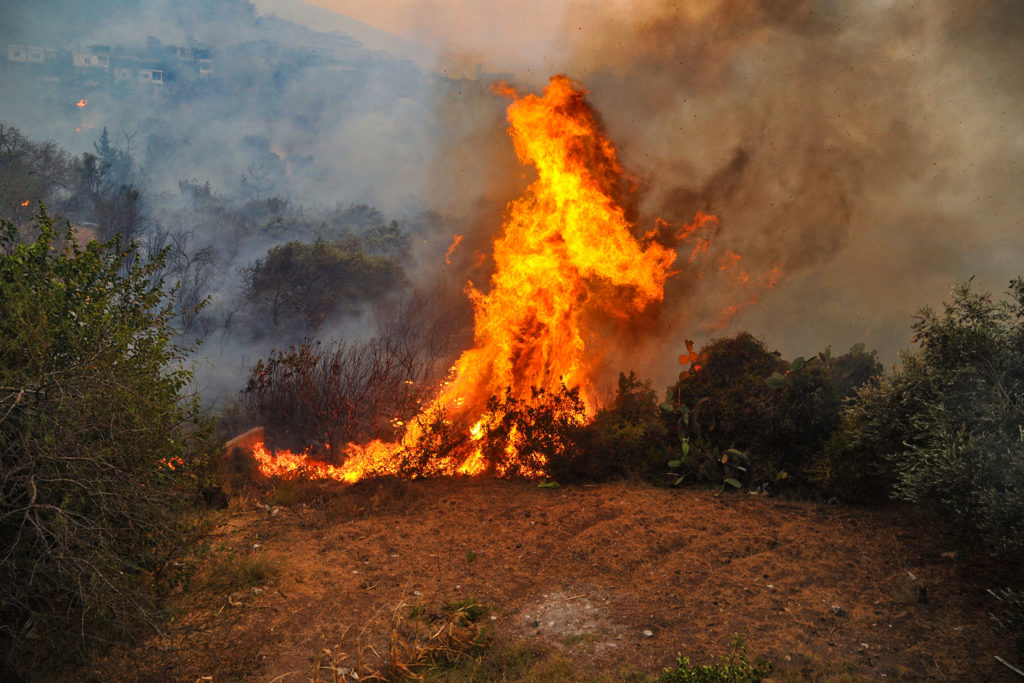Forest fires in Syria and Lebanon this year not only exceeded their natural rate, but they have also reached and scorched olive and fruit groves, as well as populated areas. The fires have destroyed hundreds of ancient perennial trees and indigenous plants, endemic to the eastern Mediterranean, and devoured huge numbers of olive trees and fruit orchards. Syria, in particular, has lost huge quantities of fruit trees.
In the town of Hob Namira alone in the governorate of Homs, approximately 1000 olive trees were burned, in addition to other fruit trees such as pomegranates, figs, and vineyards. The same was the case in other towns and villages in the same governorate, such as al-Muzayna and near Ali and Zweitina. Activists in Homs, who were contacted by phone, indicated that the fires have destroyed 80 percent of the fruit trees, specifically the olives, and 20 percent of the rest of the forests.
The forest fires in Syria and Lebanon this year have been the largest series of fires over the years in the region, and their effects will be catastrophic on agriculture, health and the environment, especially if the governmental, societal and regional response continues to be the same in dealing with them. According to the Syrian Ministry of Agriculture, the fires devoured virgin forests containing various and rare plants; in the Lattakia Governorate alone, around 600 hectares of land were burned, after 79 fires broke out, the largest number of fires in the history of Syria.
Fires in Syria and Lebanon this year.
Official and informal information about the causes of the fires have been conflicting. Some are referring to climate change as the main reason, represented by high temperatures, low levels of humidity and dry wind currents. Others are indicating that farmers burning dry weeds and cleaning land during this time of year increases the possibility of the eruption of fires, not to mention the exploitation of Syria’s forests in burning wood for agriculture and the coal trade. There is also a third party, justifying the fires as an act of sabotage…
The lower part of the Mediterranean is indeed, witnessing a marked increase in temperatures resulting from climate change, and its summers have become long, leading to the stiffness of large areas, including trees and forests. The same change has led to a decrease in humidity and an increase in dry air currents. These climatic changes will increase the strength of the fires, but the poor management of forests and woodlands and the human activities involving agriculture, charcoal, cleaning and urbanization play an important role here. The distribution points of the outbreak of the fires indicate that their sources are diverse and don’t necessarily relate to each other, meaning that the climate factor helps in speeding up their spread, but not in triggering their spark. For example, the olive groves in the Homs governorate are not connected to the coastal forests, meaning that there must be other factors, mostly human-related, having a direct relationship to the cleaning operations that involve burning grass and forest areas in a primitive manner.
Results
Forests work in filtering the components of the air and storing them, with each tree in its life cycle storing around 22 tons of carbon dioxide in its trunks, branches and root systems. Trees are also involved in the production of hydrocarbon as fuel for growth, and play a vital role in rainfall. Although the death of these trees leads to the release of carbon after the end of their life cycle by fungi and bacteria, most of them remain confined to the creative ecosystem that has permanently organized itself. Noting that ancient forests harbor tremendous biological diversity, and that their capacity to contain microorganisms and store carbon exceeds that of small forests by a very large margin. Consequently, the death of forests due to these fires releases more carbon dioxide and heat not only in Syria and Lebanon, but also throughout the entire region, because Mediterranean forests have a giant climatic effect in terms of humidity, rain and winds on the entire interior regions of the southern Mediterranean. Hence, the greenhouse gases that were absorbed by the trees will eventually find their way into our lungs, even after the fires subside.
Since forests constitute the natural habitat of microorganisms and house around 80 percent of wildlife, their destruction will lead to the release of viruses and diseases that have been harbored by the forests themselves for thousands of years, which would not only change the natural shape of the area, but would also disrupt the ecosystem in it as well. The decline in biodiversity due to forest fires, or through their exploitation for agriculture, is a direct cause of the spread of emerging infectious diseases. Deforestation is the source of most epidemics, and about 75 percent of the new viruses are of zoonotic origin, and are spread due to the way humans often displace animals from their natural habitats.
Forests constitute the natural habitat of microorganisms and house around 80 percent of wildlife, their destruction will lead to the release of viruses and diseases that have been harbored by the forests themselves for thousands of years.
Solutions
Although new trees emanating from the debris of burnt forests will not carry the ability of old trees to store carbon dioxide, and the new forests will not be able to house wildlife and micro-organisms, as the old perennials used to do, reforestation is a fundamental solution among the suggested nature-based solutions. This requires giving priority in planning policies to environmental problems and means of reforming them, starting with reforming old methods of agricultural practices, and ending with liberating environmental policies from the centralization of the failed state by activating local administrations and involving communities in managing natural systems.
Another way to confront the changes is to educate adults about climate change and the harsh phenomena that result from it. Instead of focusing on early warnings about the occurrence of fires, we should focus on awareness of climate change. Since the role of forests in protecting the natural system is global and does not concern specific regions, states, countries and societies, we must establish regional federations regarding renewable natural resources and ways to protect them, since the security of the region is directly linked to the security of those resources. In the same context, the importance of transforming virgin forests and woodlands into natural reserves, in order to protect them from human agricultural and urban activities, should be addressed in the same context.









